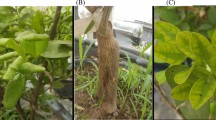Abstract
We tested citrus samples from Japan using reverse transcription-polymerase chain reaction (RT-PCR), and for the first time, Citrus viroid V (CVd-V) was detected in Japan. Using nucleotide sequence analysis, we identified two new CVd-V variants, which shared 91–96% nucleotide sequence identities with those reported previously and 89% with each other. The RT-PCR detected CVd-V from 44 of 275 citrus trees tested, showing that CVd-V can be spread to some extent within commercial orchards in Japan.


Similar content being viewed by others
References
Ito T, Ieki H, Ozaki K (2000) A population of variants of a viroid closely related to citrus viroid-I in citrus plants. Arch Virol 145:2105–2114
Ito T, Ieki H, Ozaki K, Iwanami T, Nakahara K, Hataya T, Ito T, Isaka M, Kano T (2002) Multiple citrus viroids in citrus from Japan and their ability to produce exocortis-like symptoms in citron. Phytopathology 92:542–547
Ito T, Namba N, Ito T (2003) Distribution of citrus viroids and Apple stem grooving virus on citrus trees in Japan using multiplex reverse transcription polymerase chain reaction. J Gen Plant Pathol 69:205–207
Nakaune R, Nakano M (2006) Efficient methods for sample processing and cDNA synthesis by RT-PCR for the detection of grapevine viruses and viroids. J Virol Methods 134:244–249
Serra P, Barbosa CJ, Daròs JA, Flores R, Duran-Vila N (2008a) Citrus viroid V: molecular characterization and synergistic interactions with other members of the genus Apscaviroid. Virology 370:102–112
Serra P, Eiras M, Bani-Hashemian SM, Murcia N, Kitajima EW, Daròs JA, Flores R, Duran-Vila N (2008b) Citrus viroid V: occurrence, host range, diagnosis, and identification of new variants. Phytopathology 98:1199–1204
Vernière C, Perrier X, Dubois C, Dubois A, Botella L, Chabrier C, Bové JM, Duran-Vila N (2006) Interactions between citrus viroids affect symptom expression and field performance of Clementine trees grafted on trifoliate orange. Phytopathology 96:356–368
Walter AE, Turner DH, Kim J, Lyttle MH, Müller P, Mathews DH, Zuker M (1994) Coaxial stacking of helixes enhances binding of oligoribonucleotides and improves predictions of RNA folding. Proc Natl Acad Sci USA 91:9218–9222
Zucker M (2003) Mfold web server for nucleic acid folding and hybridization prediction. Nucleic Acids Res 31:3406–3415
Acknowledgments
We thank all those who provided us with samples for this study and assisted in their collection.
Author information
Authors and Affiliations
Corresponding author
Additional information
Contribution No. 1564 of NIFTS. The nucleotide sequence data of the Citrus viroid V (CVd-V) variants reported are available in the DDBJ/EMBL/GenBank databases as accessions AB560862 and AB560863.
Rights and permissions
About this article
Cite this article
Ito, T., Ohta, S. First report of Citrus viroid V in Japan. J Gen Plant Pathol 76, 348–350 (2010). https://doi.org/10.1007/s10327-010-0254-1
Received:
Accepted:
Published:
Issue Date:
DOI: https://doi.org/10.1007/s10327-010-0254-1




